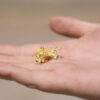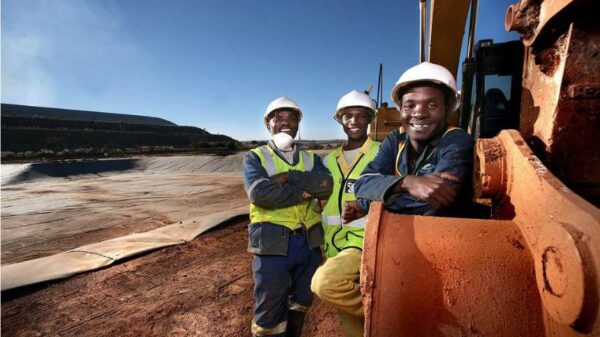Gold has remained popular throughout history due to its beauty, rarity, and ability to symbolize wealth. It’s also valued as a reliable investment, resistant to corrosion, and has various practical applications. These factors combine to make gold a precious metal with enduring appeal.
Gold’s unique qualities make it a reliable store of value during times of economic uncertainty. For this reason, investors consider it a safe haven asset. It also has a long history of retaining its worth, even when other financial assets may falter.
When economic instability or crises arise, investors often flock to gold as a hedge against inflation, currency devaluation, and stock market volatility. The metal’s limited supply and historical role as a currency further contribute to its perceived safety.
Additionally, gold is not tied to any single government or central bank, making it a globally recognized and trusted form of wealth preservation. These attributes combine to make gold a sought-after asset during turbulent times, as it provides stability and security in an otherwise uncertain financial landscape.
Outside of the affluent west, though, the story is a lot different.
For some people, it involves dangerous conditions and unsavoury characters with hazards at every turn. For others, it’s literally life or death, as its pursuit can be the cause for displacement or violence
The price of gold is approximately USD$2,068 at the time of this writing.
Here’s a roundup featuring various companies in different circumstances both politically, economically and socially, but with one common thread: they’re all chasing gold.

Mining pushes through and devastates the Munduruku Indigenous Land in the Amazon. Image from Marcos Amend via Greenpeace
Illegal gold mining proves lethal in Brazil
Brazil’s government deployed its army and police forces to eradicate illegal mining operations from the Amazon and provide assistance to the Yanomami Indigenous population. Illegal mining had proven itself to be a problem worthy of military and police intervention, and the government emphasized that all individuals involved in environmental crimes, genocidal acts or funding of illegal gold mining would face prosecution.
On Tuesday, the Brazilian Air Force announced that it had fired warning shots at a plane and compelled it to land for violating a no-fly ban over the Yanomami Indigenous reservation, an area where illegal gold miners have been returning despite federal efforts to deter them.
Following its landing on an earthen airstrip, the pilot managed to escape into the rainforest, eluding the Federal Police who had arrived to confiscate the aircraft. The plane’s involvement in illegal gold mining remains unclear, although such activities have resumed in the vast protected reservation, equivalent in size to Portugal, despite a government operation the previous year that aimed to remove around 20,000 illegal wildcat miners.
The Air Force has faced criticism for not actively enforcing the government-ordered no-fly zone, issued by President Luiz Inacio Lula da Silva on January 30 last year.
As Brazil’s military reduced its support for the government’s crackdown, gold-seeking miners have returned, exacerbating a humanitarian crisis that has led to Yanomami fatalities from diseases like flu and malaria, malnutrition, and violence in the remote Amazon rainforest. Environmental enforcers disclosed in December that unregistered planes were transporting miners back into the reservation due to the ineffective flight ban.
Read more: Calibre Mining Q3 gold production numbers exceed analyst expectations: Canaccord Genuity
Mark Bristow gushes over Kibali mine in DRC
The situation in Brazil normally bears similarities to the situation in the Democratic Republic of Congo (DRC), and other African countries.
Gold mining in the DRC plays a significant role in the country’s economy and has both positive and negative implications.
On the plus side, the DRC has vast mineral resources, including substantial gold reserves, primarily concentrated in the eastern and northeastern regions of the country.
On the negative side, informal and artisanal gold mining activities are prevalent and often characterized by small-scale operations with minimal regulation. It provides livelihoods for many local communities but also faces challenges related to environmental degradation, human rights abuses, and conflict financing. Armed groups often control some mining areas.
Conversely, this week’s news from the DRC is uncharacteristically sunny, however, as Barrick Gold Corporation (TSX: ABX) (NYSE: GOLD) president and CEO Mark Bristow spoke positively over the company’s Kibali gold mine in the DRC because the source of its energy is green.
Kibali obtains its electricity from three hydroelectric stations and a recently commissioned 16 MW solar power plant and energy storage facility.
So far, Barrick has invested a total of USD$4.7 billion in the country, including royalties, taxes, dividends, and payments to local suppliers.
The company is also actively involved in supporting biodiversity by planning to introduce more white rhinos to the Garamba National Park. Kibali successfully achieved its 2023 production goal of 360,000 oz. of gold.
Ownership of the mine splits three ways between Barrick, AngloGold Ashanti (NYSE: AU) with 45 per cent each, and Société Miniére de KiloMoto with 10 per cent.
Kibali, the largest gold mine in Africa, is now also one of the greenest mines on the African continent. https://t.co/v3iIWGzHmO $GOLD $ABX.TO
— Barrick (@BarrickGold) January 29, 2024
Nevada offers a peaceful alternative
The United States and Canada represent a significantly different experience for miners than the somewhat wild environs of the DRC or Brazil. Specifically, Nevada boasts a rich and diverse landscape of gold trends, each with its unique geological attributes and significant contributions to the state’s gold production.
The renowned Carlin Trend stands out as one of the most prolific, hosting world-class mines like Carlin, Goldstrike, and Cortez, characterized by disseminated gold deposits within sedimentary rock formations. Nevada Gold Mines, a Barrick Gold and Newmont Corporation (NYSE: NEM) (TSX: NGT) joint venture, owns these mines.
In the Battle Mountain-Eureka area, the Cortez Trend showcases both high-grade underground and expansive open-pit deposits in mines such as Cortez and Pipeline. Moving north-central, the Getchell Trend has played a historical role in gold mining, featuring operations like Turquoise Ridge and Twin Creeks, spanning both open-pit and underground mining.
The Battle Mountain-Eureka trend is to such companies as Calibre Mining Corp. (TSX: CXB) (OTCQX: CXBMF) with its Pan Mine, which is situated in White Pine County, approximately 28 kilometers southeast of the town of Ely.
Calibre Mining’s Nevada operations produced 10,519 ounces of gold. The Gold Rock project, located near the Pan mine, will start production this year, promising an increase in gold ounces from Nevada.
Meanwhile, G Mining Ventures Corp. (TSX: GMIN) (OTCQX: GMINF) announced this week that it had drawn approximately USD$42 million on its USD$75 million secured term loan with an affiliate of Franco-Nevada Corporation (NYSE: FNV) (TSX: FNV).
Read more: Calibre Mining closes top tier gold merger with Marathon Gold
Read more: Calibre Mining’s merger with Marathon Gold deemed ‘tremendous opportunity’
Alaska First Nations opposes gold mining project
A consortium of Alaska First Nations is expressing opposition to the Eskay Creek project, a large open-pit gold mine proposed by Skeena Resources (TSX: SKE) (NYSE: SKE) located just across the Alaska-Canada border.
Vancouver-based Skeena recently signed the permitting Process Charter for the Eskay Creek gold-silver project, which falls within the Tahltan Nation’s territory in the Golden Triangle of British Columbia.
The property includes the former Eskay Creek mine, which produced 3.3 million oz. of gold and 160 million oz. of silver from 1994 to 2008. The Process Charter represents a collaboration between Skeena, the Tahltan Central Government (TCG), and the Government of British Columbia.
While the Tahltan support the project, the Southeast Alaska Indigenous Transboundary Commission (SEITC) has announced their intention to seek recognition from the governments of British Columbia and Canada to safeguard the Unuk River watershed from potential harm caused by the Eskay Creek mine.
Eskay Creek is one of several proposed and operating mines along the Taku, Stikine, and Unuk rivers upstream of the US-Canada border. The consortium of Tlingit, Haida, and Tsimshian Tribal governments based in Alaska has applied to Canadian environmental regulators to have their historical presence acknowledged along the Unuk River.
They assert that the rapidly expanding transboundary mining threatens this region and conflicts with their duty to preserve traditional lands for future generations. The rivers, which are among the last remaining wild salmon habitats worldwide, hold immense cultural significance for the tribes in southeast Alaska, who fear the adverse impacts of inadequately regulated gold mining in northwest British Columbia, including the potential leaching of copper, selenium, and other toxins downstream across the border.
Some startups literally make gold out of trash
Not everything is doom and gloom. There’s still a lot of room for innovation.
Small startups are capitalizing on the untapped potential of the e-waste industry, generating up to $85,000 per day by recycling old electronic circuit boards. These initiatives are poised for further expansion, as globally there is a projected $55-$60 billion worth of precious metals worldwide within discarded circuit boards, awaiting collection.
Circuit boards commonly include gold, albeit in small quantities. Gold is used in electronic components and connections on circuit boards due to its excellent conductivity and resistance to corrosion. While the amount of gold in an individual circuit board is relatively small, considering the vast number of electronic devices produced and discarded globally, the collective gold content in e-waste can be significant.
E-waste represents a rapidly growing environmental hazard with global implications.
Furthermore, a substantial portion of our e-waste remains unrecycled, left to deteriorate in garages, landfills, and urban areas. In the United States, only approximately 15 per cent of the daily e-waste generated by its citizens is collected for recycling.
The flip side of this situation is that e-waste is rapidly emerging as one of the most underestimated “gold mines” of the modern era, primarily due to the abundance of valuable metals contained within circuit boards.
Gold mining comes with a high degree of risk
The global gold mining industry frequently receives criticism due to its negative environmental impact, unethical practices, and human rights abuses. The use of harmful chemicals like cyanide in gold extraction poses significant risks to ecosystems and local water sources, creating long-term environmental threats.
Furthermore, mining operations in certain areas have been associated with human rights violations, including forced labour and the displacement of Indigenous communities, which questions the industry’s social responsibility. Addressing these moral concerns necessitates increased transparency, stricter regulations, and a firm dedication to sustainable and ethical practices within the industry.
Volatility and potential hazards mark the gold mining sector. Gold prices, geopolitical instability, and regulatory changes can significantly impact the industry. Additionally, mining projects often require high initial investments, and returns can be influenced by external factors beyond the control of mining companies.
But there’s no reward without risk as investors know, and due diligence here can yield life changing results.
.
Calibre Mining is a sponsor of Mugglehead news coverage
.














